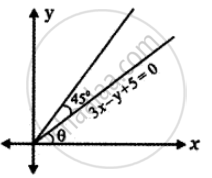Advertisements
Advertisements
Question
Find the equation of the pair of straight lines passing through the point (1, 3) and perpendicular to the lines 2x − 3y + 1 = 0 and 5x + y − 3 = 0
Solution

Equation of a line perpendicular to 2x – 3y + 1 = 0 is of the form 3x + 2y + k = 0.
It passes through (1, 3)
⇒ 3 + 6 + k = 0
⇒ k = – 9
So the line is 3x + 2y – 9 = 0
The equation of a line perpendicular to 5x + y – 3 = 0 will be of the form x – 5y + k = 0.
It passes through (1, 3)
⇒ 1 – 15 + k = 0
⇒ k = 14
So the line is x – 5y + 14 = 0.
The equation of the lines is 3x + 2y – 9 = 0 and x – 5y + 14 = 0
Their combined equation is (3x + 2y – 9)(x – 5y + 14) = 0
(i.e) 3x2 – 15xy + 42x + 2xy – 10y2 + 28y – 9x + 45y – 126 = 0
(i.e) 3x2 – 13xy – 10y2 + 33x + 73y – 126 = 0
APPEARS IN
RELATED QUESTIONS
Show that the equation 12x2 – 10xy + 2y2 + 14x – 5y + 2 = 0 represents a pair of straight lines and also find the separate equations of the straight lines.
Show that the pair of straight lines 4x2 + 12xy + 9y2 – 6x – 9y + 2 = 0 represents two parallel straight lines and also find the separate equations of the straight lines.
If m1 and m2 are the slopes of the pair of lines given by ax2 + 2hxy + by2 = 0, then the value of m1 + m2 is:
Combined equation of co-ordinate axes is:
Show that 4x2 + 4xy + y2 − 6x − 3y − 4 = 0 represents a pair of parallel lines
Show that 2x2 + 3xy − 2y2 + 3x + y + 1 = 0 represents a pair of perpendicular lines
Show that the equation 2x2 − xy − 3y2 − 6x + 19y − 20 = 0 represents a pair of intersecting lines. Show further that the angle between them is tan−1(5)
Find the separate equation of the following pair of straight lines
2x2 – xy – 3y2 – 6x + 19y – 20 = 0
Find p and q, if the following equation represents a pair of perpendicular lines
6x2 + 5xy – py2 + 7x + qy – 5 = 0
Show that the equation 9x2 – 24xy + 16y2 – 12x + 16y – 12 = 0 represents a pair of parallel lines. Find the distance between them
Prove that one of the straight lines given by ax2 + 2hxy + by2 = 0 will bisect the angle between the coordinate axes if (a + b)2 = 4h2
Choose the correct alternative:
Equation of the straight line that forms an isosceles triangle with coordinate axes in the I-quadrant with perimeter `4 + 2sqrt(2)` is
Choose the correct alternative:
The coordinates of the four vertices of a quadrilateral are (−2, 4), (−1, 2), (1, 2) and (2, 4) taken in order. The equation of the line passing through the vertex (−1, 2) and dividing the quadrilateral in the equal areas is
Choose the correct alternative:
If the equation of the base opposite to the vertex (2, 3) of an equilateral triangle is x + y = 2, then the length of a side is
Choose the correct alternative:
The image of the point (2, 3) in the line y = −x is
Choose the correct alternative:
The length of ⊥ from the origin to the line `x/3 - y/4` = 1 is
Choose the correct alternative:
If one of the lines given by 6x2 – xy – 4cy2 = 0 is 3x + 4y = 0, then c equals to ______.
Choose the correct alternative:
One of the equation of the lines given by x2 + 2xy cot θ – y2 = 0 is
If `"z"^2/(("z" - 1))` is always real, then z, can lie on ______.
